Things to see in Bagheria
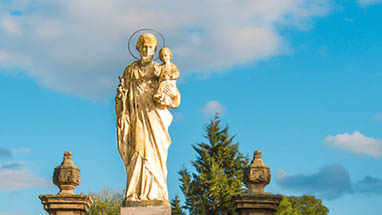
People enjoying holidays in Sicily quickly learn that Bagheria is known for two things – the mafia and its villas. And there is a connection between the two. The villas were built in the 17th and 18th centuries as summer resorts by feudal lords. And when the feudal lords were away in their palaces, these villas were left in the hands of overseers.
This was a big mistake. Because these overseers would eventually come the true rulers of Sicily – the Godfathers. It would take Bagheria centuries to transform from a summer retreat for Palermo's ruling class into a mafia stronghold. But it was here that the heroin for the famous Pizza Connection trials in the USA was "cooked".
Today, the feudal lords and even the mafia belong to history. But the villas are still here. Some of them are even open for you to enjoy - beautiful places with a troubled past.
Author
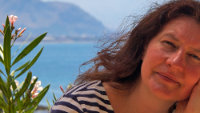
The information on this site comes from our Sicily expert Britta Bohn.
Britta has been dealing with daily life and life in Sicily for over 20 years.
Don't miss any of her tips! Subscribe to our free Newsletter:
An Invitation
Dear friends of Sicily, we invite you to join the Facebook Group "Trip-Tipp Sicily". Find answers to all your questions and discover exclusive tips for your trip to Sicily from those who have already made the journey and those who already know the island from the inside out:
Content
- Downtown – more than just shopping
- Villa Palagonia - Baroque Monsters
- The parlor of the Duke of Villarosa
- Villa Cattolica and the Italian Picasso
- Villa San Cataldo - Bagheria's Emerald
- On the red carpet at Villa Ramacca
- The Museum - Sicily's contemporary art
- Aspra - The Port of Bagheria
- Aspra - Villa Sant'Isidoro - Open to all
- Mongerbino - the sea so near
- Mongerbino - Monte Catalfano - hiking with the sea
Holidays lettings in Sicily
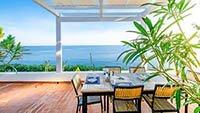
Are you looking for holiday lettings in Sicily but can't see the wood for the trees? We're not surprised, because the range of choices competing online is pretty confusing.
To make it simple, we present a small selection of quality holiday rentals, each one chosen for an unusual feature to make your holiday in Sicily extra special... more
Fashion made in Sicily

Sicilian fashion? Dolce & Gabbana?
Sure! But fashion designed and manufactured in Sicily is the real insider tip.
Like that of the Sicilian designer Filly Cusenza from Bagheria. She creates wearable art made of fabric, thread and buttons. Her trademark and label name is the fancy cartoon girl Filly Biz... more
The Essence of Sicily

Downtown – more than just shopping
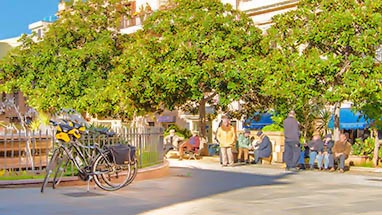
Bagheria's city center is a pedestrian area (turquoise line on the map). Why is this special? Pedestrian zones are almost unheard of in Sicily. The tiny, winding streets of medieval towns were suitable for pedestrians and donkey carts in their time, of course. But with today's cars, well, pedestrians and donkeys have to scatter pretty quickly. There isn't any choice.
Bagheria's pedestrian area is a compromise. In the afternoons and early evenings it is completely closed to cars – as well as completely on weekends. But in the morning and late at night automobiles can pass through at max. 30 km/h.
So if you are pursuing one of the finest dreams of those enjoying holidays in Sicily – sitting outside at a cafe and just watching the people go by – the afternoon is the perfect time for it. Tip: the pedestrian zone is closed to cars at around 14:00, but the city only comes alive anyway at about 16:00. That is when the siesta ends.
Of course, once you've taken in the surroundings you may be interested in shopping. Those who are after Italian fashion do not need to go all the way to Palermo. It is everywhere. Sicily, of course, is home to Domenico Dolce.
Villa Palagonia - Baroque Monsters
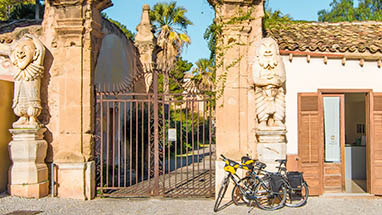
Bagheria is known as the "City of Villas" and Villa Palagonia (brown Marker 20 on the city map) is iconic for its own reasons: notice the "monster" by the entrance (see photo to the right).
A real monster? Well, today he would probably qualify as a little bit cute. And all the other characters – especially on the outside walls – provoke little more than a second glance.
In the 18th century, however, things were a bit different. Villa Palagonia was a must-see for those taking holidays in Sicily – and it was regularly panned. Goethe wrote, for example, in his "Italian Journey":
"The loathesomeness of these botched little deformities with their shoddy craftsmanship..."
The famous Germanist Achim Aurnhammer explained the negative reaction to Villa Palagonia this way: "Those enjoying their holidays in Sicily in the 18th century above all were interested in the remnants of ancient Greece. Baroque villas did not fit their expectations. And certainly not baroque monsters with shriveled faces – a scandal!"
But why monsters in the first place? The whim of some madman? An evil plan by the Prince of Darkness? No one knows for sure. The only reliable information is that it was not the original client – the Prince of Palagonia – who commissioned these figures, but rather his grandson.
Whatever the original reason, today a visit to Villa Palagonia is certainly worth it. Today holidaygoers in Sicily find the Villa surrounded by the city of Bagheria. But this image (below) shows the Villa in the latter half of the 18th century when it had its huge garden:
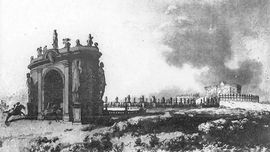
In those days, the giant gate in the foreground was the main entrance. It connected to a long path "guarded" by monsters which led into the main building. Today the gate seems a bit lost in the middle of the city and has even acquired a religious significance (Arco del Padre Eterno, brown Marker 21 on the city map). The image comes from the book "Voyage pittoresque des isles de Sicile, de Malte et de Lipari" by French painter J. Houel (1735-1813).
- Opening hours at Villa Palagonia.
- Rosario Scaduto - Villa Palagonia - Storia e Restauro.
- TripAdvisor reviews of Villa Palagonia.
The parlor of the Duke of Villarosa
Palazzo Villarosa (brown Marker 15 on the city map) was built in the 1700s by the Duke of Villarosa. Villarosa is in the Sicilian heartland, but like so many such buildings, naturally it had to be in Bagheria. Especially if it was to serve one of the most important noble families in Sicily - the Notarbartolos. As the Sicilian aristocracy declined, their property fell more and more into "common" hands. This was the case with Palazzo Villarosa. It was purchased just before the Second World War by the Aiello family. Thankfully, it was renovated and today serves as an exceptional spot for meetings, receptions, and weddings. If you have something like this in mind, click here.
If you would like a virtual tour:
- Click or tap the green circle in the center of the image to start the tour
- Click or tap the red carpet to go the entrance to the villa
- Click or tap in front of you to go inside
- Drag the image with mouse or finger to the left, right, top or bottom
- Click or tap a point in the image to zoom in

Villa Cattolica and the Italian Picasso
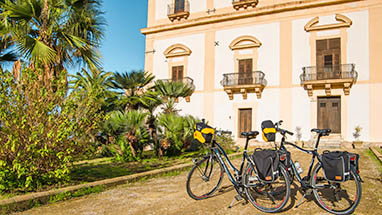
An Italian Picasso? From Sicily? It must be news to art critics! But let's start at the beginning – with the construction of Villa Cattolica (brown Marker 6 on the city map).
The sheer size of Villa Cattolica tells us right away that it was built by a very powerful family - the Bonannos. The Bonannos? For anyone who has delved into Sicilian Mafia lore, the name surely rings a bell.
But it's not as clear-cut as all that: The mafia Bonannos were definitely from Sicily, and at the start of the 20th century even spread to New York. But their exact family relationship with the original owners of Villa Cattolica still isn't clear.
Today Villa Cattolica is owned by the city of Bagheria. At its heart is a permanent exhibition of one of the "greatest sons" of the city – the painter Renato Guttuso. He was a politically-inspired artist who in many resembled his friend and idol Pablo Picasso. Guttuso's own reaction to Picasso's anti-war painting Guernica is "The Crucifixion" (1941).
Of course, the naked Mary Magdalene in the painting caused a huge scandal in Catholic Italy in 1941 – and made Guttuso more famous than ever. But Guttuso was not interested in scandal for scandal's sake. In his painting, Guttuso wanted to depict humanity's irrational cruelty in a timeless way. Giving Mary Magdalene period-specific clothing would have distracted from this goal.
A major theme of Guttuso's was the world's use of violence to settle scores. Guttuso was a staunch anti-fascist, and yet at the same time was a Communist and an honored guest in Moscow. Of course, Moscow under Stalin and in subsequent days was a strange place to be if you were anti-violence. But perhaps hindsight is 20/20.
Guttuso's early works can be seen at Villa. Major works like "The Crucifixion" can be found at the National Gallery of Modern Art in Rome. This video gives a brief overview of his work:

- Villa Cattolica Homepage
- TripAdvisor reviews of Villa Cattolica
Villa San Cataldo - Bagheria's Emerald
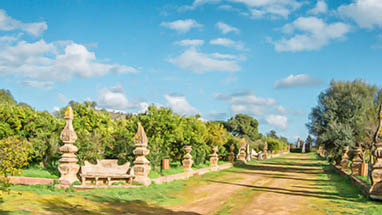
Hard to believe, but Villa San Cataldo (brown Marker 8 on the city map) owes its existence to the cities of Pisa and Florence and to the Visconti family. "Visconti" and "Sicilian" – do these ring a bell? Exactly! A scion of this family was Luchino Visconti, Oscar-winning director of the Sicilian film The Leopard.
His ancestor Gabriele Maria Visconti was Baron of Pisa at the start of the 15th century and sold the city in 1406 to archrival Florence. This put Pisa's elite under considerable pressure. Many of them packed their bags and moved to Sicily. Existing trade relations between Pisa and Palermo made this easier.
Among the exiles was the Galletti family. They rose to become one of the most powerful feudal families in Sicily. They would be remembered for building a special baroque villa in Bagheria: Villa San Cataldo. In the 1800s, baroque was out and Gothic was back in. The Villa was completely remodeled into a very formidable looking fortress. It is now part of the law school of University of Palermo – shame on you for seeing a connection.
The great garden is more than a little interesting for Sicily holidaygoers. It has not been remodeled, and is one of the few remaining gardens from the original Sicilian Baroque. In 2013, the city of Bagheria restored the garden, jewel that it is, and reopened the wonderful green space to the public and to all those enjoying their holidays in Sicily.
The image above was taken in Winter 2014/15. Winter is a great time for a visit. In Bagheria everything is still green, orange trees offer up their fruit, and one has the place practically to himself. Tip: Bring along a nice, comfortable cushion. The garden's stone benches invite you to take long breaks.
- Homepage of Villa San Cataldo's garden.
On the red carpet at Villa Ramacca
Villa Ramacca was built in the 18th century by the famous Sicilian noble family, the Gravina. It has Norman roots and ties to the family of Richard Wagner.
The end of Spanish rule in Sicily meant the end for Villa Ramacca (brown Marker 5 on the city map). First it was turned into a barracks and then a hospital, and finally it fell into disuse. After a long period of neglect it again felt the hammer and was bought and renovated by famous entrepreneur Baldassarre Scaduto. Today Villa Ramacca is used for meetings, receptions, and weddings. If you would like to use the venue, click here.
Use this panorama to explore the red carpet and the entrance to Villa Ramacca:
- Click or tap the green circle at the center of the image to start the panorama
- Drag the image to the right, left, top, and bottom
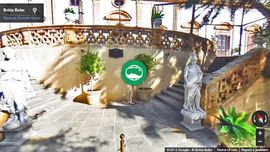
The Museum – Sicily's contemporary art
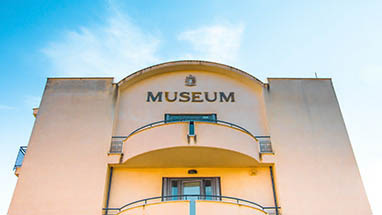
No, it's not a misprint: the Museum of Contemporary Art in Bagheria (brown Marker 9 on the city map) is usually just called "the Museum". Of course, that's not the reason why it's so well known internationally – more so than even its hometown of Bagheria.
The driving force behind the establishment of the Museum in 1948 was Bagheria-born gallery owner Ezio Pagano. It is said that he was ready to join the art scene in Bagheria already when he was in "short pants". Among those especially helped and influenced by him were painter Renato Guttuso, Oscar-winning director Giuseppe Tornatore and member of the legendary photography agency Magnum, Ferdinando Scianna.
Bored with studying law in Palermo, Pagano opened Bagheria's first gallery in 1965. But he soon grew restless and opened another gallery - again in Bagheria. And since all good things come in threes, Pagano soon opened a third. Ezio Pagano had by now established a reputation in the art world, and so even the great Renato Guttuso was shown at the newest gallery.
Pagano now had plenty to do. It was only in the 1990s that Pagano was ready to undertake a new project. His goal was the international distribution of Sicilian contemporary art. And so the "Museum" was born – with the subtitle "Gallery of Sicilian Contemporary Art".
International attention only comes, of course, to those who interact with the world. Having an exhibition space is just part of it. For art lovers enjoying holidays in Sicily, a visit to this exciting gallery is a must. This video gives a taste of an exhibition in Bagheria:
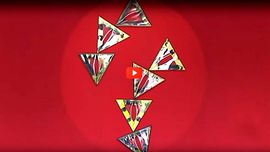
- Museum Homepage
- Opening times and admission fees
- Museum catalog [PDF, 5MB]
Aspra – the Port of Bagheria
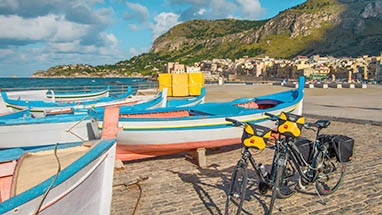
Aspra District is the Port of Bagheria (brown Marker 2 on the city map).
You won't find any giant cruise ships here, just the colorful little fishing boats that are the hallmark of Sicily. As a matter of fact, fans of our finned friends can buy fish for dinner right out of the boat.
If you don't like to eat fish, the new and spacious boardwalk will still give you your money's worth. There is plenty to see, eat, and drink here during your holidays in Sicily. And it's the focus of this video:
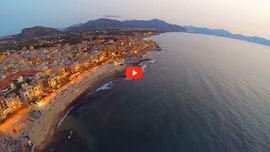
- Stay updated! Subscribe to our free Newsletter.
Aspra - Villa Sant'Isidoro – Open to all
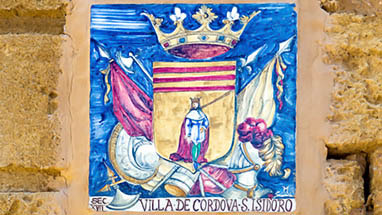
Come on in! Villa Sant'Isidoro (brown Marker 4 on the city map) is the second baroque villa that you can enjoy during your holidays in Sicily. And this one is a powerful symbol of the transformation of feudal Sicily into a modern society.
This is because Villa Sant'Isidoro was originally a "masseria" – which is a kind of fort-and-farm combination. It was with these setups that feudal lords – including The Leopard – brought Sicily under control.
In the 17th and 18th centuries these landowners became so rich they were able to build palaces for themselves in Palermo and giant villas for themselves as summer homes in Bagheria. The owner of this particular masseria couldn't be left behind and as a result rebuilt it as Villa Sant'Isidoro.
But decadence usually means the end has begun. The fall of the Leopards was well underway in the 19th century and accelerated in the 20th century. No one would shed a tear today for the old feudal system. But what was to happen to the beautiful old mansions?
Maria Teresa De Cordova, the last owner of Villa Sant'Isidoro from the nobility decided to transfer ownership to the "bourgeois" Domenico Angileri. Unlike his mafia-linked contemporaries, Angileri did not bulldoze his grand old property.
Instead, Angileri renovated and restored the Villa, started a cultural association with academic support, and opened the Villa to the public. Anyone with even a little knowledge of Sicily cannot rate Angileri's effort and achievement in this direction highly enough.
In this video, members of the cultural association along with Domenico Angileri explain what visitors get to see. It can be understood without speaking Italian:
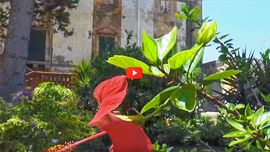
- Opening hours at Villa Sant'Isidoro.
Mongerbino – the sea so near
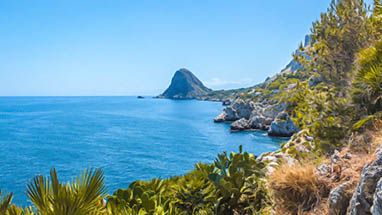
For many of us the sea is a place in our dreams. We want to hear waves from the terrace telling us to take a swim before we've eaten breakfast.
We want to watch in the evening with a glass of red wine as the sun sets beneath the waves. This dream comes true for all who enjoy holidays in Sicily – here along the rocky coast of Mongerbino (red frame above on the map).
Between Aspra in the west and Capo Zafferano in the east, this tiny stretch of coast – from which one has a fantastic view of Palermo – is particularly beautiful to look at in the evening when the sun sets over the Monte Pellegrino.
And best of all: you can rent a room here in holiday apartments just a few meters from the water.
Mongerbino - Monte Catalfano – hiking with the sea
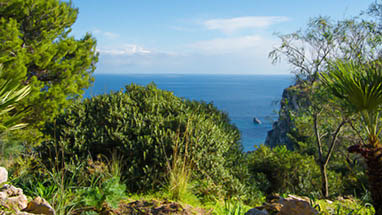
Right next to the sea in Bagheria stands 370m-high Monte Catalfano (brown Marker 1 on the city map) – waiting to be climbed by you during your holidays in Sicily.
You can take an easy hike up a well-paved road – and be rewarded with a magnificent view of Capo Zafferano and the Gulf of Palermo. Shady woods, Mediterranean shrubs, and rare orchids line the quiet, relaxing paths.
The vicinity is dotted by numerous caves, some of which are easily reached. Those looking to get outside and move around while getting close to nature will find Monte Catalfano the perfect spot.